Meselson and Stahl experiment gave the experimental evidence of DNA replication to be semi-conservative type. It was introduced by the Matthew Meselson and Franklin Stahl in the year 1958. Matthew Meselson and Franklin Stahl have used E.coli as the “Model organism” to explain the semiconservative mode of replication.
There are three modes of replication introduced during the 1950s like conservative, semi-conservative and dispersive. The researchers were confused between these three that what could be the actual pattern of DNA replication. In 1958, Matthew Meselson and Franklin Stahl presented their research, where they concluded that the replication of DNA is semiconservative type.
Matthew Meselson and Franklin Stahl have conducted several experiments after the discovery of DNA structure (by the two scientists Watson and Crick). Watson and Crick’s model is widely accepted to demonstrate the replicative model of DNA. We will discuss the definition, steps and observation of the Meselson and Stahl experiment along with the semi-conservative model of DNA.
Content: Meselson and Stahl Experiment
- Definition
- Semi Conservation Model of DNA
- Meselson and Stahl Experiment Steps
- Observation
- Conclusion
Definition of Meselson and Stahl Experiment
Meselson and Stahl Experiment gave us the theory of semi-conservative replication of DNA. They have taken E.coli as the model organism and two different isotopes, N-15 and N-14. The N-15 is the heavier isotope, whereas N-14 is the lighter or common isotope of nitrogen. Meselson and Stahl performed their experiment by first growing the E.coli in the medium containing 15NH4Cl for several generations. They observed that the heavy isotope has incorporated in the genome of E.coli and the cells become more substantial due to 15N heavy isotope.
Meselson and Stahl then transferred the E.coli cells incorporated with 15N isotope to the medium containing 14NH4Cl for several generations. After every twenty minutes, the E.coli cells multiply. For the processing of DNA, the cells were centrifuged by the addition of Caesium chloride, resulting in the formation of the concentration gradient. As a result, light, intermediate and heavy DNA strands will get separated.
After completing their experiment, Meselson and Stahl concluded that after each cell division, half of the DNA would be conserved for every next generation. Therefore, this experiment proves that the DNA replication obeys the semi-conservative mode of replication in which 50% of the DNA conserve for every next generation in a way like 100%, 50%, 25%, and 12.5% and so on.
Semi Conservation Model of DNA
It is the type of DNA replication. The term semi means “Half” and conservative means “To store”. The semi-conservative DNA replication results in the two daughter DNAs after the parent DNA replication.
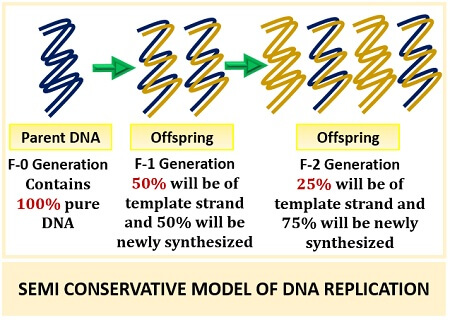
In the two daughter DNA’s, each strand will contain a mixture of the parent DNA’s template strand, and the other with a newly synthesized strand (in F-1 gen). When the parental DNA replicates, half of the 100%, i.e. 50% of the DNA is conserved by having parent strand and the remaining 50% will produce newly synthesized strands.
After the F-1 gen, the multiplication of the cell will get double, which will produce four DNA strands (in F-2 gen). In F-2 gen half of 50%, i.e. only 25% of DNA is conserved by having parental strands, and the remaining 75% will produce newly synthesized strands.
Meselson and Stahl Experiment Steps
Meselson and Stahl performed a series of an experiment, which includes the following steps:
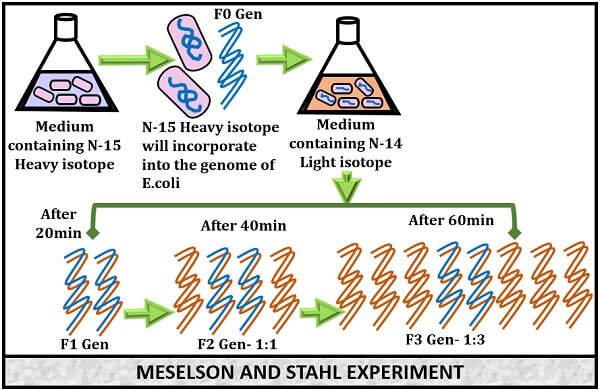
- Growth of E.coli: First, the E.coli were grown in the medium containing 15NH4Cl for several generations. NH4 provides the nitrogen as well as a protein source for the growth of the E.coli. Here, the 15N is the heavy isotope of nitrogen.
- Incorporation of 15N: After several generations of E.coli, Meselson and Stahl observed that the 15N heavy isotope has incorporated between the DNA nucleotides in E.coli.
- Transfer of E.coli cells: The DNA of E.coli labelled with 15N isotope were transferred to the medium containing 14NH4Cl. Here, the 14N is the light isotope of nitrogen. The E.coli cells were again allowed to multiply for several generations. The E.coli cells will multiply every 20 minutes for several generations.
- Processing of DNA: For the processing or separation of DNA, the E.coli cells were transferred to the Eppendorf tubes. After that, caesium chloride is added, having a density of 1.71 g/cm3 (the same of DNA). Finally, the tubes were subjected to high-speed centrifugation 140,000 X g for 20 hours.
Observation
After centrifugation, the DNA separates based on mass or density. Different DNA bands like heavy, intermediate and light DNA forms as a result of the concentration gradient created by CsCl.
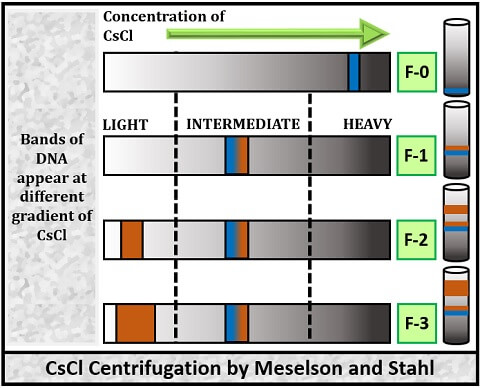
The light DNA will consist of a pure 14N isotope. An intermediate DNA band will indicate the combination or mixture of both 15N and 14N isotopes. The occurrence of heavy DNA bands will consist of a pure 15N isotope.
Conclusion
The result, after two generations of E.coli, the following results were obtained:
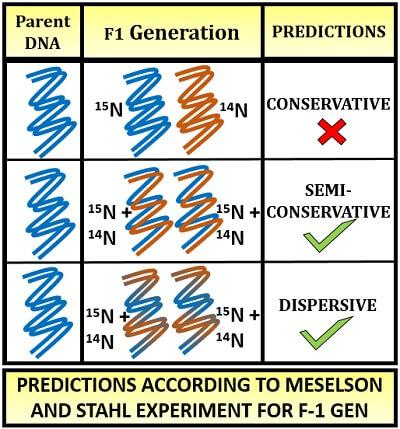
In the F-1 generation: According to the actual observations, two DNA strands (with a mixture of both 15N and14N isotopes) will produce in F-1 gen. The above diagram shows that the semiconservative and dispersive model obeys the pattern of growth explained by Meselson and Stahl.
Thus, it is clear that the DNA does not replicate via “Conservative mode”. According to the conservative model, the DNA replicates to produce one newly synthesized DNA and one parental DNA. Therefore, the conservative model was disapproved, as it does not produce hybrid DNA in the F-1 generation.
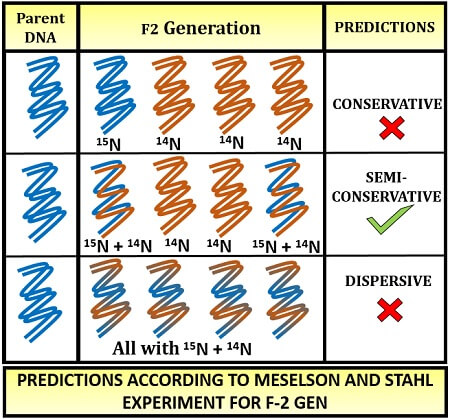
In the F-2 generation: According to the actual observation, four DNA strands (two with hybrid and the remaining two with light DNA) will produce in the F-2 generation. The hybrid DNA includes a mixture of 15N and 14N. The light DNA strands contain a pure 14N. The diagram shows that only semi-conservative type of replication gave similar results conducted by Meselson and Stahl. Thus, both the conservative and dispersive modes of replication were disapproved.
Therefore, we can conclude that the type of replication in DNA is “Semi conservative”. The offsprings have a hybrid DNA containing a mixture of both template and newly synthesized DNA in the semi-conservative model. After each multiplication, the number of offspring will double, and half of the parental DNA will be conserved for the next generation.